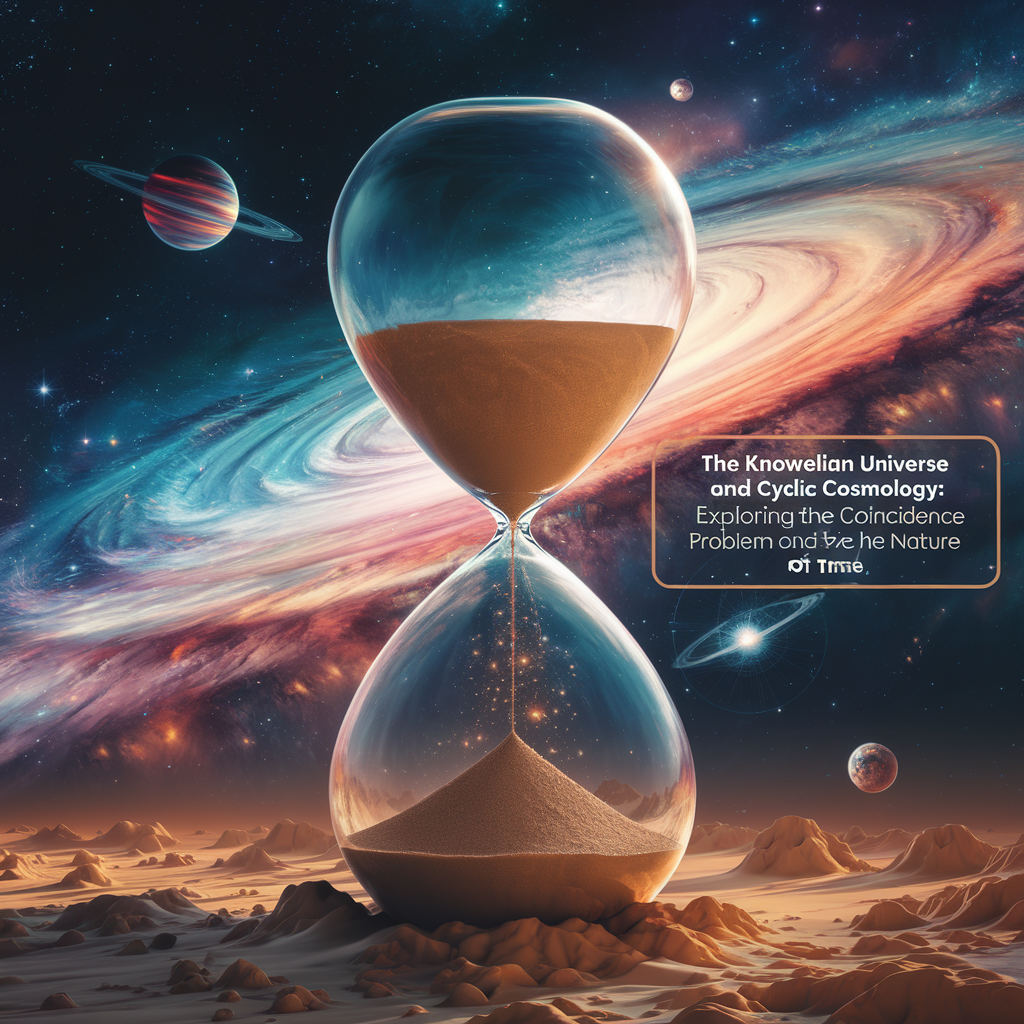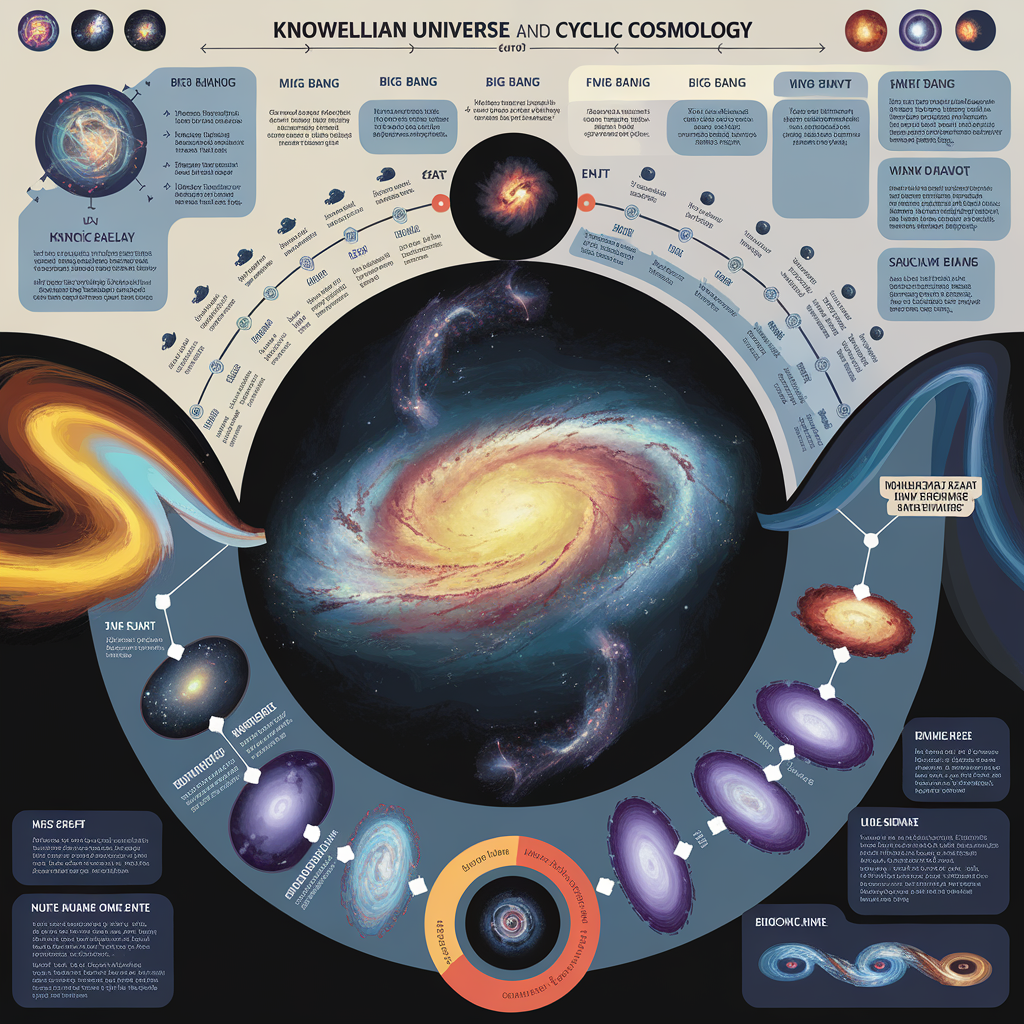
The KnoWellian Universe and Cyclic Cosmology:
"Exploring the Coincidence Problem and the Nature of Time."

Abstract: This paper explores the potential intersection between the KnoWellian Universe (KUT), a novel cosmological model proposing a cyclical universe driven by the interplay of "Control" and "Chaos," and the framework of cyclic cosmological models based on general relativity and scalar field dynamics, as developed by Ijjas, Steinhardt, and others. While both frameworks share a cyclical motif and address established cosmological puzzles, they differ significantly in their underlying mechanisms and treatment of time and infinity. We examine the key convergences and divergences, focusing on how each model might offer a pathway towards addressing the cosmic coincidence problem. We also discuss the limitations and open questions for both frameworks, highlighting potential areas for future research.
1. Introduction
The standard model of cosmology (ΛCDM) has proven remarkably successful in explaining a wide range of observations. However, fundamental questions about the very early universe and the nature of dark energy remain unanswered. In recent years, cyclic models, which posit a universe undergoing endless cycles of expansion and contraction, have emerged as a compelling alternative to the standard Big Bang inflationary paradigm. These models, often based on the dynamics of a scalar field within general relativity, offer elegant solutions to several cosmological puzzles, including the flatness, homogeneity, and isotropy of the universe.
Concurrently, a novel cosmological framework called the KnoWellian Universe Theory (KUT) has been proposed, offering a different perspective on the cyclical nature of the universe. The KUT envisions a universe driven by the dynamic interplay of two fundamental, opposing forces or states of being: Ultimaton (control) and Entropium (chaos). This paper aims to explore the potential intersection and points of divergence between these two cyclical frameworks, focusing particularly on their potential implications for addressing the cosmic coincidence problem and their divergent conceptualizations of time.
2. The KnoWellian Universe: A Primer
The KUT posits a universe without a beginning or end in the conventional sense. It eternally oscillates between phases of emergence (expansion driven by Ultimaton) and dissolution (contraction driven by Entropium). These two forces engage in a continuous, dynamic interplay at the KnoWellian Interpause, a transition zone symbolized by the singular infinity symbol (∞). The CMB arises in the KUT from the residual friction of the energy exchange between particles and waves occurring at the Interpause. This continuous generation of CMB radiation implies that spacetime is infinitely large to accommodate the constant energy output from the Interpause.
Central to the KUT is the KnoWellian Axiom of Mathematics: "-c > ∞ < c+," which redefines the concept of infinity and provides the framework for KnoWellian Ternary Time. Negative speed of light (-c) symbolizes emergent particle energy, positive speed of light (c+) symbolizes collapsing wave energy, and ∞ is the singular infinity where the transition between particle and wave states occurs. KnoWellian Ternary Time fractures Einstein’s singular notion of time into three simultaneous dimensions: past (-c), instant (∞), and future (c+).
3. Cyclic Cosmological Models: A Brief Overview
Cyclic models, as developed by Ijjas, Steinhardt, and others, propose a universe undergoing repeated cycles of expansion and contraction, driven by the dynamics of a scalar field with a negative potential energy. These models differ significantly from previous cyclic models by positing a "gentle bounce," a smooth, non-singular transition between contraction and expansion, which avoids the Big Bang singularity. A key feature of these models is "slow contraction," a phase where the universe contracts slowly, smoothing and flattening spacetime while stretching quantum fluctuations to superhorizon scales. These fluctuations then seed the formation of structures during the subsequent expansion phase. The cyclic models also explain the negligible quantity of the Weyl tensor right after the bounce, as the universe is dominated by a scalar field with negative potential. The entropy is partitioned in a way that is consistent with CMB and astrophysical observations. These models also predict a temporary dark energy-dominated era, driven by quintessence, that eventually transitions to a phase of slow contraction.
4. Convergences and Divergences
While both frameworks offer cyclic cosmologies and resolve standard cosmological puzzles, their fundamental mechanisms and conceptualizations of time diverge sharply.
Convergences:
Cyclical Nature: Both the KUT and the cyclic models propose an eternal universe without a singular beginning or end.
Resolving Cosmological Puzzles: Both address the flatness, homogeneity, and isotropy of the universe.
Divergences:
Mechanism of the Cycle: Cyclic models are grounded in the dynamics of a scalar field within general relativity. The KUT invokes a more metaphysical interplay between "Control" and "Chaos."
Nature of Time: The cyclic models use the standard concept of linear time, while the KUT proposes Ternary Time (past, present, and future coexisting).
Nature of Infinity: The cyclic models employ the conventional understanding of infinity, while the KUT introduces a singular infinity connecting opposite extremes.
The CMB: Cyclic models posit a single generation of CMB anisotropies per cycle. The KUT suggests continuous creation at the Interpause.
Scale Factor and Hubble Parameter: Cyclic models involve an oscillatory Hubble parameter with an ever-increasing scale factor. KUT describes continuous simultaneous oscillations, creating a steady-state model.
5. The Cosmic Coincidence Problem: Potential Pathways to a Solution
The cosmic coincidence problem asks why the energy densities of dark matter and dark energy are of the same order of magnitude at the present epoch, despite their drastically different effects on cosmic expansion. Both cyclic models and the KUT offer potential, though speculative, approaches to understanding this puzzle.
Cyclic Models: The cyclic nature and dark energy instability predicted by these models suggest that the coincidence might be a transient phenomenon associated with a particular phase of the cycle. The model specifies constraints on how long the current accelerated expansion phase can last given by equation (1.1) in Ref [8] and in [10]. If each cycle starts with similar initial conditions, it might explain the recurrence of the coincidence. However, a deeper understanding of how exactly this might happen is an open question for these models.
KUT: The
continuous interplay between Ultimaton and Entropium at the
KnoWellian Interpause suggests a potential balance between these
opposing forces, which might account for the observed similarity in
energy densities. If dark energy is somehow related to Entropium, as
the author suggests, the current balance we observe might reflect a
deeper connection between these fundamental forces. The exact
connection between
dark
energy and entropium is an open question. Furthermore, the KUT's
concept of Ternary Time could offer an alternative way to
conceptualize the coincidence: if past, present, and future are
inextricably linked, the current balance between matter (past) and
dark energy (future) might be a natural consequence of this
interconnectedness.
6. The Missing Matter Problem: A KnoWellian Solution
The KUT offers a novel perspective on the missing matter problem.
It suggests that the "missing" matter isn't absent butresides in the
unobservable dimensions of past (-c) and future (c+)
time. We perceive only the "foam" of matter/energyinteracting at the
Interpause (∞), the intersection of these
temporal dimensions. This limited temporal perception confines us
toobserving a fraction of the total matter content, creating the
illusion of "missing" matter.
This perspective doesn't negate the existence of dark matter within our
observable slice of spacetime. However, it suggests that what we currently
perceive as "missing" might be a consequence of our limited temporal
perception, rather than a fundamental lack of matter. Just as a
two-dimensional being might perceive a three-dimensional object as a
series of disconnected slices, we might be perceiving a small fraction of
the universe's total matter content due to our confinement to the
“Instant.”
7. Limitations and Open Questions
Both frameworks face limitations and unanswered questions:
Cyclic Models: While these models offer a compelling mechanism for the cycle, they don't yet fully explain why the universe began large and slowly contracting or why certain parameter values are chosen. A deeper understanding of the initial conditions and the underlying physics behind the scalar field potential is needed. More importantly, the models have not yet been experimentally verified, and further research is needed to produce more definitive testable predictions. They haven’t yet presented a compelling reason as to why the dark energy should be unstable.
KUT: The KUT’s greatest challenge lies in its lack of formalization within established physics. The concepts of "Ultimaton," "Entropium," and "Interpause" are not well-defined in terms of known physical entities or interactions. Translating these concepts into a mathematically rigorous framework and integrating them within general relativity or a suitable modified theory of gravity is crucial for the KUT to be considered a viable scientific model. Furthermore, the continuous creation of CMB implied by the KUT requires careful examination to ensure consistency with thermodynamic principles and observational constraints. There is no explanation as to why the universe always remains infinitely large.
Both the KUT and the cyclic cosmological models
provide intriguing frameworks for understanding the universe’s cyclical
nature. While they differ significantly in their mechanisms and
conceptualizations of time and infinity, both offer potential pathways
towards addressing the cosmic coincidence problem. The cyclic models,
grounded in established physics, require further development to fully
explain the coincidence’s origins and to make more specific testable
predictions. The KUT, offering a more radical, consciousness-centered
paradigm, faces the critical challenge of translating its concepts into
a mathematically rigorous framework and integrating them with known
physics. Further explorations of both frameworks, particularly focused
on addressing their limitations and open questions, could potentially
yield valuable insights into the universe's fundamental nature. Further
research is needed to explore these approaches.
